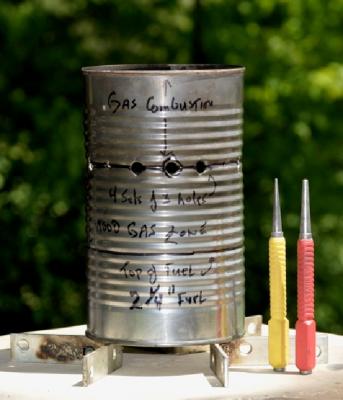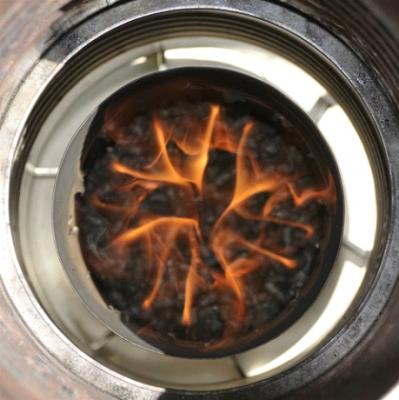Jock Gill, May 2010
With one can: I can make a stove I can cook a meal I can make biochar I can be carbon negative I can start to change the world
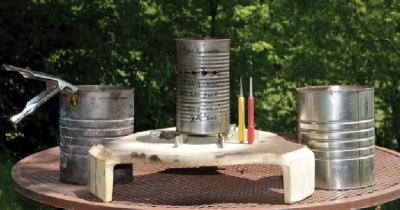 This iCan is made from a 7" tall pineapple juice can
This iCan is made from a 7" tall pineapple juice can
I took a 7" tall pineapple juice can, removed the contents, and then marked it thusly:
1. A line around the can 1/3 from the bottom --- this is the top of the fuel load
2. A line around the can 1/3 from the top -- this is the line for the secondary air holes
The middle section is for the wood gas buffer to insure pyrolysis, not combustion.
Next
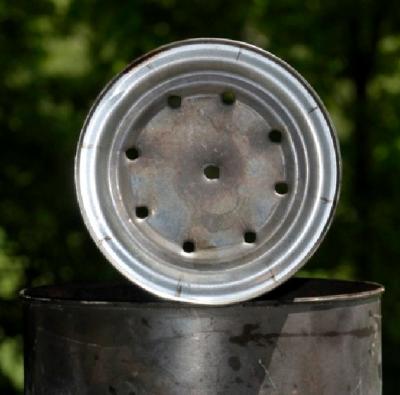 Primary air supply for a 7" tall pineapple juice can
Primary air supply for a 7" tall pineapple juice can
Marked the bottom of the can off into 8 equal sections. I then used a nail set to make 8 equally spaced holes about half way between the outside of the can and its center. I made a 9th hole in the center. Not too big -- about 1/2 way down the small nail set shaft.
Then I used the line1/3 down from the top to locate the secondary air holes.
I made 8 equally spaced holes with the small nail punch and then used the the biggest punch to enlarge the holes to the full width of its shaft.
At this point I removed the top of the can completely. I left it on for the best structural integrity while I was punching holes.
Done. The All-in-One TLUD is complete. Very simple. Just 17 holes in the right places in one can.
More pictures, are also available at: http://www.flickr.com/photos/jockgill/sets/72157624142002304/
and click here for more story details: http://www.bioenergylists.org/node/2827
It "burns" very nicely and lasts about 35 minutes on what amounts to a mere inch and a half of wood pellets. Burns VERY cleanly. Very nice flame pattern as well. A great deal more "blue" in the flames. Seems to be a much better ratio of wood gas to secondary air.
I used this basic approach on a smaller can only 4 1/2 inch tall, but only use 6 holes around the middle of the bottom with one in the center. Also used 6 secondary air holes. This one burns with 6 beautiful dancing flame tips.
Aslo tested a big bigger 5.5 inch tall can as well. All three performed very well.
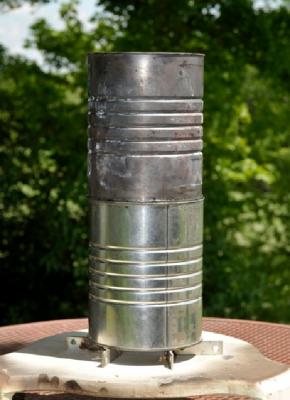 Two large cans, acting as draft protectors, with the iCan TLUD inside.
Two large cans, acting as draft protectors, with the iCan TLUD inside.
I put my test All-in-Ones in the center of a stack of two large coffee cans to make sure the very windy conditions did not too much disturb the burns.
By doing this, I avoided any wind "blow outs" requiring re-lights.
My new water quenching technique.
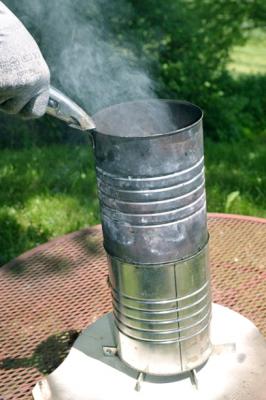
Removing the top outer can at end of run. Gloves are optional.
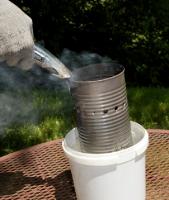 quenching iCan in a bucket of water
quenching iCan in a bucket of water
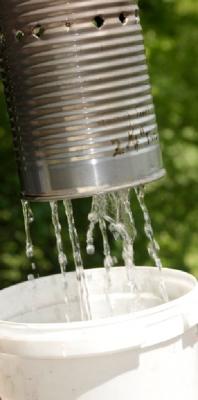 Quenching water flowing out of iCan
Quenching water flowing out of iCan
-- WARNING --- -- WARNING --- -- WARNING --- -- WARNING --- -- WARNING --- -- WARNING --- -- WARNING ---
A one gallon iCan TLUD, even with just 40 oz of wood pellet fuel in it, a quart and 1/3, has a great deal of energy that comes out as a very vigorous flame AND, when quenched in water, produce a burst of LIVE STEAM.
IF you want to do a water quenching of a large iCan, be sure that the tool you will grab the very hot iCan with has a significant OFFSET from the top of the iCan so that the live steam burst will not hurt you. Also, for this size can you MUST wear heavy gloves as an extra layer of protection when handling the hot iCan.
NEVER let a young person quench a one gallon, or larger, iCan TLUD!
Please ALWAYS be VERY CAREFUL when dealing with iCans larger than a pineapple can. All iCan TLUDs must always be handled with a great deal of respect and care. There is a great deal of energy in biomass and it can hurt you if you are not very careful.
-- WARNING --- -- WARNING --- -- WARNING --- -- WARNING --- -- WARNING --- -- WARNING --- -- WARNING ---
My first iCan Cook Out
Cooked myself up a delicious dinner tonight on my iCan TLUD stove. Menu: A couple of kosher hot dogs, carrot sticks, bread & butter pickles, beer, marshmallows, and soon: some Ben & Jerry's ice cream!
Turns out 1 pint of wood pellets, 16 oz, slightly less than 500 ml, fills the 7" tall can 1/3 of the way - the design point.
Burn ran for over 40 minutes. Time enough to cook at least 10 hot dogs one at a time as well as marshmallows.
Best way to cook marshmallows is to insert them into the hot wood gas zone just above the charcoal.
After I quenched the charcoal in water, at about the 43 minute mark, I had 8 oz, by volume, of biochar -- well drained.
When I crushed a charcoal pellet between my fingers, it simply rinsed off in the now warm quenching water. No oily residue at all.
Having students make an iCan TLUD from a single can, then having them cook their next meal on their just made stoves, and finally to have them see the biochar their cooking made, is very powerful.
One Can 在手,万事不愁
有了One Can,
我就可以制作炉子;
可以烹饪美味佳肴;
可以生产生物炭;
可以做到负排碳。
有了One Can,
我便能够改变世界!
Lighting the iCan Stove
TLUD stands for Top Lit Up Draft. It is important that the fire start on the top of the fuel and slowly work its way down thru the fuel. You do not want any fire below the active pyrolysis layer.
Here is how you light the Peacham iCan All-in-One TLUD stove.
1. take a handful of wood pellets and put them in a can or jar;
2. cover with 91% rubbing alcohol;
3. Let sit 90 - 120 seconds;
4. Pour excess alcohol back into its container -- I use a funnel and sieve to do this.
5. Shake off excess alcohol from the soaked pellets -- this is important. You do not want any starter below the top of the fuel!
6. distribute soaked pellets evenly across the TOP of the fuel in the iCan.
7. Drop a match in.
Done.
Thanks to Hugh McLaughlin who taught me the basics of this technique.
You will get a hot blue flame on top of the fuel. As the fuel heats and starts to give off gas, the flames turn yellow and gradually rises off the fuel base to the ring of secondary air holes.
When the yellow flames go out and the iCan starts to smoke, the burn is over. Quench the biochar in a bucket of water.
Jock Gill
Pellet Futures / Biochar NE
P.O. Box 3
Peacham, VT 05862
Carbon Negative Solutions
(G) (802) 503-1258Nike Air Max 270

